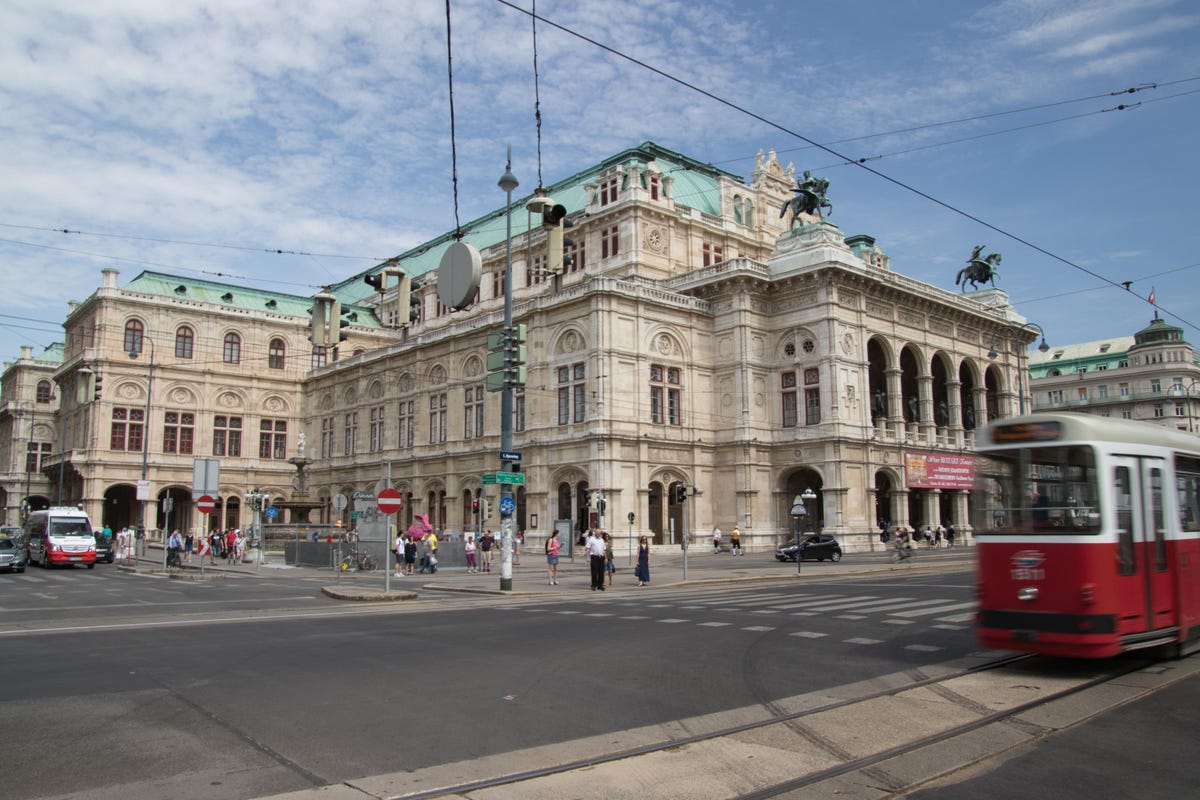
Wiener Staatsoper
Completed in 1869, the Vienna State Opera sits proudly on the city's Ringstrasse and is one the most legendary opera houses in the world.
For the story behind this tour, check out Keep it classical: A tour of the stunning Vienna Opera House.
Tours
If you don't have time for a show, there are multiple tours most days, which is what I did.
Entrance
One of the oldest parts of the building, the entrance, not surprisingly needs periodic maintenance.
Multilingual
A number of tours leave at the same time, each in a different language, and they follow predetermined routes so there's minimal overlap. That, and the construction, meant my tour didn't go up the central staircase, but that didn't stop me...
Feststiege
The walls and ceiling of the main staircase, also called the "Feststiege."
Staircase
The staircase survived the war, looking as stately now as it must have done when it was new, nearly 150 years ago.
Lighting
I'm going to go out on a limb and say it's all a lot brighter now, though.
Statues
Josef Gasser designed the seven statues that overlook the stairway, representing the seven "liberal arts" of architecture, dance, drama, music, painting, poetry and sculpture.
O Fortuna
The ceiling fresco, "Fortuna, ihre Gaben streuend" ("Fortune, scattering her gifts") was painted by Viennese painter Franz Josef Dobiaschofsky, who died two years before the opera house was completed.
Schwind foyer
The foyer is named for the painter Moritz von Schwind, whose 16 paintings here depict various operas.
Beautiful all over
If the elaborate ceiling wasn't a giveaway, this part of the building also survived the war.
The man himself
A bust of Wolfgang Amadeus Mozart. You can tour the house where he was born if you go to Salzburg, a few hours by train.
Loggia
The patio, so to speak, adjacent to the Schwind foyer, that overlooks the Ringstrasse.
Statues by Ernst Julius Hähnel are of heroism, tragedy, fantasy, comedy and love. These are what you can see in the arches from the street.
Refreshments
Just what every intermission needs: snacks and a beverage.
Marble mural
A stark contrast to the Neo-Renaissance design of the rest of the building, but it fits with the rest of the Marble Hall.
Tea salon
Once called the Emperor's Salon, this is where Emperor Franz Joseph I (he of WWI fame) would entertain his guests. You can rent this grand room during the day, or for your own use before and after a performance. How's that for living in style?
Box doors
Access to the many boxes that comprise the walls of the auditorium.
Auditorium
Every performance has a maximum audience of 2,284, including seats, standing spaces and wheelchair spots.
Curtains
A literal iron curtain separates the audience from backstage. There are two more to protect the side stage and deeper backstage, all in case of fire.
Heavier than they look
When rebuilt in the '40s and '50s, the boxes were formed from concrete, but covered in wood for better acoustics.
Tarps
I was wondering why only some of the seats were covered by protective tarps. Then I looked up...
Light maintenance
The original chandelier was replaced by this 7-by-5 meter (23-by-16.4 foot) light ring that weighs 3,000 kg (6,600 pounds) and has 1,100 bulbs.
Little boxes
You'd think the boxes would all offer a superlative view, but that's where you find most of the sichteinschränkung, or seats with restricted view.
I'm standing in the orchestra pit, which can hold around 110 musicians.
Dressing rooms
Down here are the many dressing rooms, all off limits to visitors.
Backstage
The massive backstage. It's hard to get a sense of it with the curtain down, but this area is nearly as large as the auditorium.
Watch your step
This hole drops several stories down, so from lowest point to highest point, back stage is even bigger than the auditorium.
Side backstage
I wasn't even at the edge of the backstage area for the previous two photos -- this is the area behind where I was standing. It's a vast space, and I can only imagine how crazy it must be when packed full of performers, stage hands and sets.
Evening
Tours are only available in the afternoon but they're nearly every day. There's also a performance nearly every night.
Almost perfect
I saw this shot coming and patiently waited for the carriage to get to the perfect position and by chance, no traffic!
...and the tram arrived at that exact moment. Shot ruined. Oh well, I got plenty of great photos on a delightful tour. You can read all about it in Keep it classical: A tour of the stunning Vienna Opera House.

